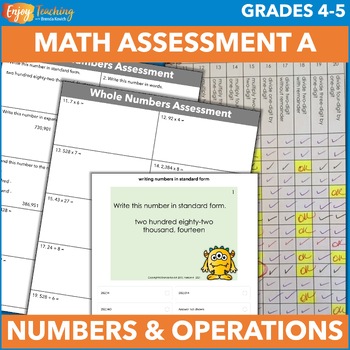Beginning of the Year Whole Number Math Assessment - Test for 4th or 5th Grade
- PDF
- Easel Activity
- Easel Assessment
Also included in
- Three tests provide fourth and fifth grade whole number assessment throughout the year. Problems address numbers in base ten standards that ask students to write, compare, round, add, subtract, multiply, and divide. Grab this bundle to inform your math instruction.Open the previews to take a closerPrice $12.00Original Price $15.00Save $3.00
Learning Objective
Students will write, compare, and round whole numbers. Students will add, subtract, multiply, and divide whole numbers.
Description
Gather baseline data at the beginning of the year. Twenty math questions pinpoint fourth or fifth grade students’ strengths and weaknesses with whole numbers and operations. This test is available as a printable worksheet, a digital Easel Activity, a self-grading Easel Assessment, or task cards.
Open the preview take a closer look.
Each whole number skill has been carefully deconstructed. This way, you can assess students' ability to write, compare, round, add, subtract, multiply, and divide. When data is recorded on the included checklists, you will understand and be able to address individual needs. It's a simple diagnostic or placement tool for numeration and basic operations.
Targeted math skills are addressed in the assessment:
- writing in standard form
- writing in words
- writing in expanded form
- comparing using <, >, and =
- rounding to the nearest ten, hundred, and thousand
- adding without regrouping
- adding with regrouping
- subtracting without regrouping
- subtracting with regrouping
- subtracting without regrouping
- subtracting across zeros
- multiplying one digit one digit
- multiplying two digits by one digit
- multiplying three digits by one digit
- multiplying four digits by one digit
- multiplying two two-digit numbers
- dividing one digit by one digit
- dividing two digits by one digit without a remainder
- dividing two digits by one digit with a remainder
- dividing three digits by one digit with regrouping
- dividing four digits by one digit with regrouping
Files include everything you need:
- 2-page printable worksheet
2-page digital test
Link to self-grading Easel Assessment - 20 task cards
- "I Can" checklist - Each student can track his/her own progress with numbers in base ten and operations.
- Teacher checklist – The checklist lets you plan grouping or math remediation. Keep it handy until all students have mastered every concept.
- Themed awards – Acknowledge mastery of whole numbers with these cute awards.
- Themed checklist – Communicate with parents. At a glance, they’ll know which skills to practice at home.
- Answer key
Resources can be used in a variety of ways.
- Whole class assessment
- Test prep
- Small group work, remediation, or tutoring
- Homework
- Sub plans
A variety of formats are included:
- printable PDF
- digital Easel Activity (kids write and draw on assessment)
- self-checking multiple-choice Easel Assessment
- print-and-cut task cards
Students engage with a full range of standards related to numbers in base ten and operations. For example:
- CCSS 4.NBT.A.2,.4.NBT.A.3,.4.NBT.B4, 4.NBT.B.5, 4.NBT.B.6
- Texas TEKS MA.4.2.B, MA.4.2.C, MA.4.2.D, MA.4.4.D, 4.MA.4.4.E, MA.4.4.F
- Virginia SOL CE.4.4.a, CE.4.4.b, CE.4.4.c, NS.4.1.a, NS.4.1.b, NS.4.1 c
Listen to what other teachers are saying about this set of tools:
- "Super helpful assessment and tracking tool. I used this as a beginning-of-year pre-assessment and will use at the end of year as well to show students their growth." – Monika B.
- "Excellent for my SPED kiddos – Thank you!" – Katie K.
Looking for a yearlong solution? Check out the whole numbers assessment bundle! It includes three parallel math tests for the beginning, middle, and end of the year, as well as cumulative record-keeping sheets for the class and individual students.
Of all the resources in my store, this is the one thing I could not live without.
- The assessment provides valuable data, which informs math instruction and remediation.
- It helps me form year-long, ad-hoc, and tutoring groups.
- The record-keeping sheets let me know who still needs help - and who doesn't.
Seriously, it's a lifesaver!
Enjoy teaching,
Brenda Kovich







